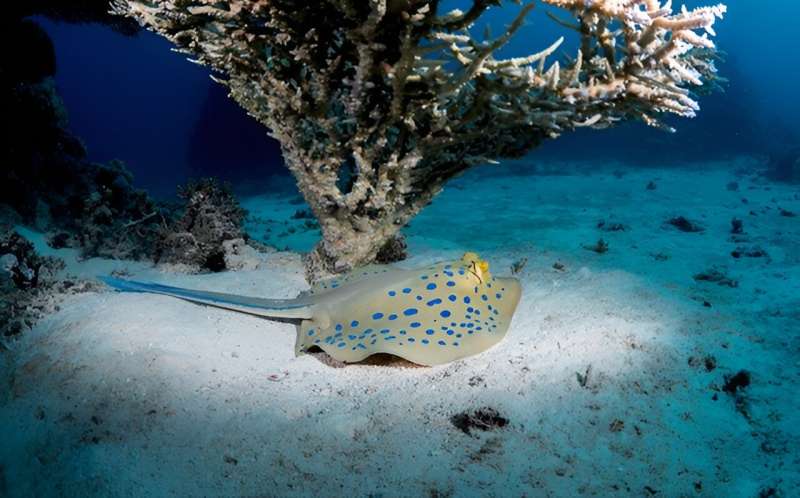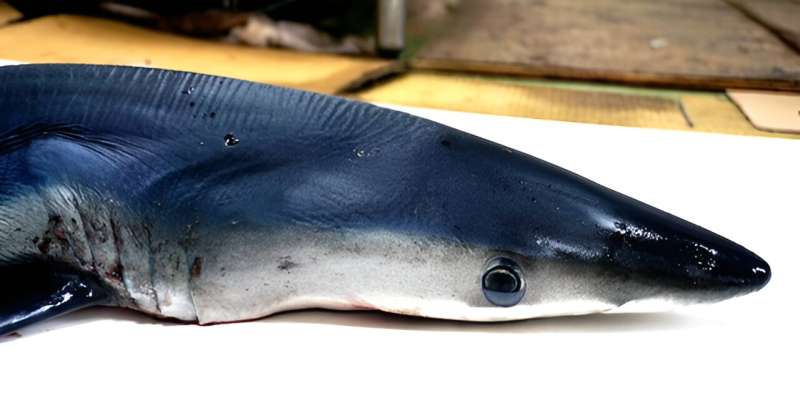
Bluespotted stingray. Credit: Morgan Bennet Smith
Researchers have discovered the unique nanostructures responsible for the electric blue spots of the bluespotted stingray (Taeniura lymma), with potential applications for developing chemical-free coloration. The team is also conducting ongoing research into the equally enigmatic blue coloration of the blue shark (Prionace glauca).
This research, titled “Ribbontail Stingray Skin Employs a Core–Shelf Photonic Glass Ultrastructure to Make Blue Structural Color,” is published in Advanced optical materials .
Skin coloration plays a key role in how organisms communicate, providing vital visual cues that can warn, attract, or camouflage. Blue-spotted ribbon rays have striking electric blue spots on their skin. However, the biological processes that produce these electric blue spots have remained a mystery until now.
“If you see blue in nature, you can be pretty sure it’s made by tissue nanostructures, not pigments,” says Mason Dean, associate professor of comparative anatomy at City University of Hong Kong (CityU). “Understanding structural color in animals is not just about the optical physics, but also the materials involved, how they’re finely organized in tissues, and how the color appears in the animal’s environment. To put all these pieces together, we brought together a great team of disciplines from multiple countries, which allowed us to come up with a surprising and fun solution to the stingray color puzzle.”
Structural colors are produced by extremely small structures that manipulate light, rather than by the product of chemical pigments.
“Blue colours are particularly interesting because blue pigments are extremely rare and nature often uses nanoscale structures to produce blue,” says Viktoriia Kamska, a postdoctoral fellow studying natural colouration mechanisms at CityU. “We are particularly interested in ribbontail stingrays because, unlike most other structural colours, their blue colour does not change when you look at them from different angles.”
The research team combined various techniques to understand the architecture of the skin under different natural conditions.
“To understand the fine-scale architecture of the skin, we used computed tomography (micro-CT), scanning electron microscopy (SEM) and transmission electron microscopy (TEM),” explains Dr. Dean.
“We found that the blue color is produced by single skin cells, with a stable 3D arrangement of nanoscale spheres containing reflective nanocrystals (like pearls suspended in bubble tea),” says Amar Surapaneni, a postdoc in Dean’s group until recently, and now a visiting professor at Trinity College Dublin. “Since the size of the nanostructures and their spacing are a useful multiple of the wavelength of blue light, they tend to reflect blue wavelengths specifically.”

Blue shark. Credit: Viktoria Kamska
Interestingly, the team found that the unique “quasi-ordered” arrangement of the spheres helped ensure that the color remained unchanged regardless of the viewing angle.
“And to eliminate all the extraneous colors, a thick layer of melanin beneath the color-producing cells absorbs all the other colors, resulting in extremely bright blue skin,” says Dr. Dean. “In the end, the two types of cells work together perfectly: the structural color cells focus on the blue color, while the melanin pigment cells suppress the other wavelengths, resulting in extremely bright blue skin.”
The team believes this fascinating blue coloration may provide camouflage benefits to stingrays.
“In water, blue penetrates deeper than any other colour, allowing animals to blend into their surroundings,” says Dr Dean. “The bright blue spots on stingray skin don’t change depending on the viewing angle, so they may have specific camouflage benefits when the animal is swimming or moving quickly with flapping wings.”
Applications of this research currently being explored include pigment-free bio-inspired colored materials.
“We are pursuing collaborations with other researchers to develop flexible, structurally colored biomimetic systems inspired by the soft nature of stingray skin for safe, chemical-free colors in textiles, flexible displays, screens and sensors,” says Dr. Dean.
In addition to their work on stingrays, Dr. Kamska and his team also study the blue coloration of other rays and sharks, including the blue shark.
“Although the name blue shark and its ecological aspects are well studied, no one yet knows how the blue colour is produced on its skin,” says Dr. Kamska. “Preliminary results demonstrate that this colouring mechanism is different from that of the stingray. But just like the stingray, we need to try different combinations of precision imaging tools and address several related disciplines in optics, materials science and biological sciences.”
There is also an article forthcoming in Frontiers of cell biology and developmenttitled “Intermediate filaments spatially organize intracellular nanostructures to produce the bright structural blue of ribbontail stingrays across ontogeny.”
This research is presented at the annual conference of the Society for Experimental Biology in Prague from July 2 to 5, 2024.
More information:
Venkata A. Surapaneni et al., Ribbontail stingray skin uses a core-shell photonic glass ultrastructure to create a blue structural color, Advanced optical materials (2024). DOI: 10.1002/adom.202301909
Provided by the Society for Experimental Biology
Quote:A new blue: Mysterious origin of ribbon ray’s electric blue spots revealed (2024, July 4) retrieved July 5, 2024 from https://phys.org/news/2024-07-blue-mysterious-ribbontail-ray-electric.html
This document is subject to copyright. Apart from any fair dealing for the purpose of private study or research, no part may be reproduced without written permission. The content is provided for informational purposes only.